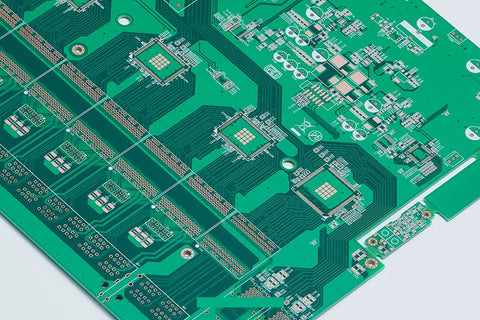As the needs for environmental protection become more and more urgent, more electronic products adopt halogen-free PCBs, which are safe to health and recyclable. This article will tell you what a halogen-free PCB is, its advantages and manufacturing, and why halogens in PCB are not welcome.

What is Halogen-Free PCB
According to IEC 61249-2-21 and JPCA-ES-01-2003 standards, halogen-free copper clads should have Cl (chlorine) and Br (bromine) of respectively within 0.09 wt% (weight percent) (900ppm) and the toll of Cl and Br within 0.15 wt% (1500ppm). So we can define halogen-free PCBs as printed circuit boards having chlorine within 0.09 wt% (900ppm), bromine within 0.09 wt% (900ppm), and the toll of halogens within 0.15 wt% (1500ppm).
Halogen-Free PCB Materials
Halogen-free FR4 materials include but are not limited to Panasonic's R1566, R1566WN, R1566W, R1566S, Ventec's VT-447, ITEQ's IT-170GRA1TC, Isola's DE156 and GreenSpeed series, ShengYi's S1550G, S1165, S1165M, S6015.
Halogen-free PCB substrates usually refer to halogen-free FR4 materials that use P (phosphorus) or N (nitrogen) to replace halogens. And the ink used for the solder mask of the PCB is halogen-free.
What is Halogen in PCBs
In the periodic table, halogens are the 6 elements that constitute Group 17 (Ⅶ), and they are F (fluorine), Cl (chlorine), Br (bromine), I (iodine), and At (astatine). Astatine is a radioactive element and is not used in electronics products, so halogens usually mean only F, Cl, Br, and I.
In the past, the halides PBB and PBDE were used in copper-clad as flame retardants for PCBs. Fortunately, PBB and PBDE were banned in copper clads for PCBs. But bromine flame retardant is still used for halogen-containing PCBs such as normal FR4 PCBs and CEM-3 PCBs, and the flame retardant is usually brominated epoxy resin.
Why Are Halogens in PCBs Harmful to Health
When PBB and PBDE are burned, they release highly toxic black smokes that contain dioxin and benzofuran. For this reason, both the EU and China ban PBB and PBDE in electronics products.
However, there are no laws in the world to ban bromine flame retardant other than PBB and PBDE in copper-clad used in PCBs. At temperatures of more than 200℃, the traditional FR4 PCBs and CEM-3 PCBs that use tetrabromobisphenol A flame retardant release a small amount of HBr (hydrogen bromide). When they are burned, a lot of brominated smoke is generated. Though FR4 PCBs and CEM-3 PCBs that contain halogens are allowed to use, they are not halogen-free PCBs.
How Do Halogen-free PCBs Be Fire-Resistant

As mentioned, halogens are used as a flame retardant in PCBs, so how do halogen-free PCBs be fire-resistant without halogen flame retardant?
Ceramics and metal are non-toxic and have high-temperature resistance. Ceramics PCBs are highly fire-resistant by nature. Aluminum PCBs and copper substrate PCBs are also fire-resistant, though they have a PP layer between the metal substrate and circuit layer. What halogen-free PCBs that need a little more explanation are those that use halogen-free flame retardant.
Most halogen-free PCBs substrates use P (phosphorus) and/or N (nitrogen) flame retardant. For the halogen-free PCBs using P flame retardant, when the phosphorus-containing resin is burned, it becomes meta-polyphosphoric acid which has strong dehydration property, and this forms a carbonized film on the surface of the resin. In this way, the air and the resin are insulated, and the resin stops burning.
For the halogen-free PCBs that use P and N compound flame retardant, when phosphorus and nitrogen compound containing resin is burned, it releases incombustible gas, and this stops the resin to burn.
Advantages of Halogen Free PCBs
- Halogen-free PCB substrates have better electrical insulation. P and N have smaller polarity than halogens, and thus halogen-free materials have reduced polarity compared with bromine-containing materials. For this reason, halogen-free PCBs can withstand a higher electric shock.
- Halogen-free PCBs have a smaller thermal expansion coefficient. P and N replacing Halogens leads to a larger monomer molecular weight of the PCB, and the mobility of molecules is lower than that of conventional epoxy resin. Thus, halogen-free PCBs have more thermal stability and less thermal expansion than traditional PCBs that contain halogens.
- Halogen-free PCBs have a higher TG. TG is the glass melting point, and a higher TG means the PCB can work at higher temperatures and be used for higher power applications.
- Halogen-free PCBs have a smaller moisture absorption rate. P and N compound epoxy resin has a smaller chance to form hydrogen bonds with hydrogen atoms in water than halogen epoxy resin does. So the moisture absorption of halogen-free PCBs is less than normal PCBs using halogen flame retardant.
Thus, compared with normal PCBs using halogen flame retardant, halogen-free PCBs have more stability, reliability, and improved performances.
